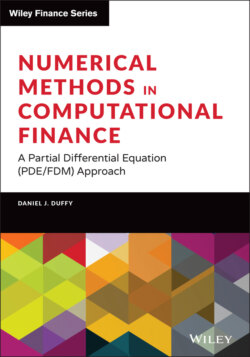Читать книгу Numerical Methods in Computational Finance - Daniel J. Duffy - Страница 44
2.4.3 Extrapolation
ОглавлениеWe give an introduction to a technique that allows us to improve the accuracy of finite difference schemes. This is called Richardson extrapolation in general. We take a specific case to show the essence of the method, namely the implicit Euler method (2.11). We know that it is first-order accurate and that it has good stability properties. We now apply the method on meshes of size k and k/2, and we can show that the approximate solutions can represented as follows:
Then:
Thus, is a second-order approximation to the solution of (2.1).
The constant is independent of , and this is why we can eliminate it in the first equations to get a scheme that is second-order accurate. The same trick can be employed with the second-order Crank–Nicolson scheme to get a fourth-order accurate scheme as follows:
Then:
In general, with extrapolation methods we state what accuracy we desire, and the algorithm divides the interval into smaller subintervals until the difference between the solutions on consecutive meshes is less than a given tolerance.
A thorough introduction to extrapolation techniques for ordinary and partial differential equations (including one-factor and multifactor parabolic equations) can be found in Marchuk and Shaidurov (1983).
